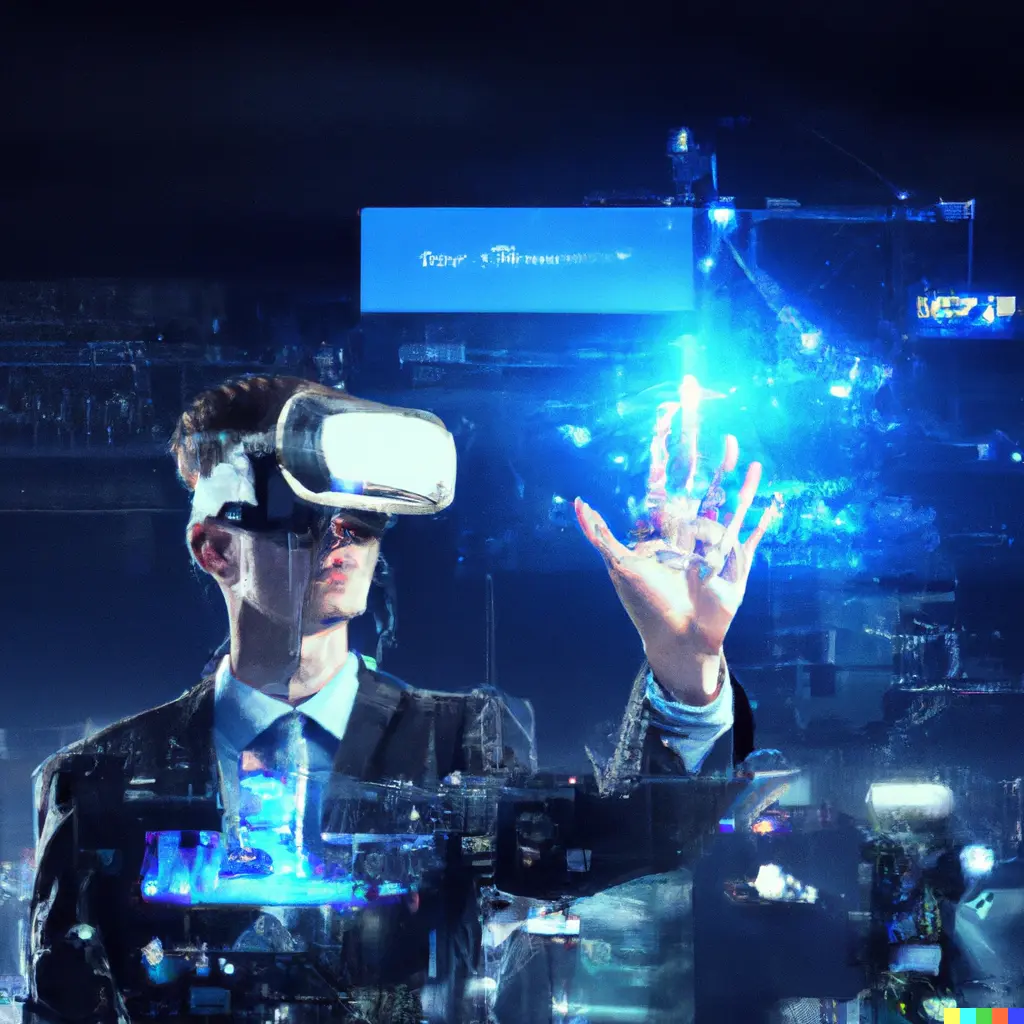Introduction
The word “metaverse” refers to a shared virtual space that is made when real life and virtual life come together. It’s an idea that’s been around for a long time, but recent technological advances have made it more likely to happen. The tech industry and people outside of it are interested in the metaverse because it could change the way we live, work, and talk to each other.
Neal Stephenson used the term for the first time in his science fiction book “Snow Crash,” which came out in 1992. In the future, people will be able to talk to each other in a shared virtual space called the Metaverse. Since then, the idea has been explored in movies, TV shows, and video games, among other forms of media.
The metaverse is now more than just a made-up idea. Companies like Facebook and Epic Games are putting a lot of money into virtual reality and other new technologies, making it more likely to happen. As our world continues to become more digital, the metaverse is likely to become a big part of our lives in the coming years.
Defining the Metaverse:
The metaverse is a virtual world made up of virtual reality, augmented reality, and other immersive technologies. It’s a shared space that anyone can get to from anywhere and at any time. People can talk to each other in the metaverse, which is a virtual world that looks and feels like the real world.

Key features of the Metaverse:
The metaverse’s most important features are its ability to create immersive and interactive experiences, to make it possible for people to talk to each other, and to open up new business and economic opportunities. The metaverse can also be accessed by many different kinds of devices, from smartphones to virtual reality headsets.
Differences between the Metaverse, Internet, and Virtual Reality:
The internet is a network of connected computers that lets people share information. The metaverse, on the other hand, is a fully immersive and interactive virtual world. The metaverse is also different from virtual reality because it can be used for more than one thing. Virtual reality usually refers to a specific app or device that gives a fully immersive experience. The metaverse, on the other hand, includes a wide range of virtual interactions and experiences.
Overall, the metaverse is a new and interesting idea that could change the way we talk to each other and interact with the world around us. As technology keeps getting better, the metaverse is likely to become an even bigger part of our lives.
Historical Context of the Metaverse:
The idea of the metaverse comes from science fiction books and movies, where it was often shown as a kind of virtual reality in the future. Neal Stephenson used the word “metaverse” for the first time in his 1992 book “Snow Crash,” which was about a shared virtual space where people could go and talk to each other.
When virtual worlds like Second Life were made in the early 2000s, the idea of the “metaverse” began to take shape in the tech world. In Second Life, people could make their own virtual characters, talk to other people, and build their own homes and businesses. Even though Second Life didn’t reach its full potential, it helped other virtual worlds like World of Warcraft and Minecraft get started.
Thanks to improvements in virtual reality and other immersive technologies, the metaverse is getting more attention again. Companies like Facebook and Epic Games have put a lot of money into developing the metaverse. Facebook has even said that it will build a metaverse in the next few years.
A lot of things, like the rise of the internet and the growing importance of digital experiences in our lives, have affected the growth of the metaverse. As technology changes, we can expect the metaverse to change and grow as well, with new uses and applications appearing over time.
Current State of the Metaverse:
Even though the metaverse is still in its early stages, there are already a lot of exciting things happening in the space. Virtual reality technology is improving quickly, and new headsets and devices are coming out that make the experience even more real. This has led to the creation of new virtual worlds and apps, such as games, social networks, and tools for getting work done.
Along with virtual reality, blockchain technology is also a big part of how the metaverse is growing. Blockchain makes it possible to make decentralized virtual worlds and economies where users can own and trade virtual assets like digital real estate, clothing, and even virtual pets. This has led to the creation of new blockchain-based platforms like Decentraland, where users can make their own virtual environments and interact with them.
Key Players in the Metaverse Space :
There are a number of important players in the metaverse space, and each of them has a different idea of what the future of the metaverse will be like. Facebook is one of the most important players, and it wants to make a fully immersive metaverse that people can access with virtual reality headsets. Epic Games, which made the popular game Fortnite, is also investing in the development of the metaverse. They want to make a virtual world that combines gaming, social media, and live events.
Decentraland is another important player in the metaverse space. It has a blockchain-based virtual world where users can make, own, and trade virtual assets. Roblox, a popular gaming platform where users can make their own content, and Somnium Space, a virtual world that combines virtual reality with blockchain technology, are also important players in the metaverse space.
Overall, the metaverse is an interesting place that is changing quickly and could change how we live, work, and talk to each other in the digital world. As technology keeps getting better, we can expect to see more and more creative uses and applications in the years to come.
The Social and Economic Impact of the Metaverse:
Society and the economy may be affected by the metaverse. The metaverse’s potential to revolutionize work and learning is tremendous. Regardless of location, virtual workspaces and classrooms could foster creativity and collaboration. Businesses could save on real estate and other costs associated with physical workstations.
Social connections can also be transformed by the metaverse, which allows people from around the world to participate in shared virtual places. For those who feel lonely or unable to connect with others in the physical world, this may improve mental health and well-being.
But, the metaverse has risks. Privacy is a major issue since people may share personal data online. Some people may grow addicted to the metaverse and abandon their real-world duties.
Those who can invest in virtual assets and settings may have an advantage over others who can’t, raising concerns about economic inequality. Developers and governments must address these issues to make the metaverse accessible and inclusive.
The metaverse could change how we live, work, and interact online. It’s crucial to acknowledge the potential benefits of this new technology and try to mitigate its risks. The metaverse’s impact on our future will be fascinating.

Metaverse futures are thrilling and difficult. As technology advances, the metaverse could become a fully immersive, networked world where users can socialize, attend virtual concerts, and conferences.
Decentralization, where users govern their virtual places, is one metaverse tendency. Blockchain technology could improve virtual transaction transparency and security.
Key Challenges to the Metaverse
To reach its full potential, the metaverse must overcome many fundamental difficulties. Interoperability between virtual platforms can be a problem. This could split the metaverse, limiting users to certain virtual areas.
Another problem is making the metaverse accessible and inclusive for everybody, regardless of socioeconomic class, geography, or physical ability. Digital literacy, broadband connectivity, and affordable virtual hardware are needed.
Ultimately, the metaverse’s ethical and moral issues, particularly privacy and data security, must be addressed. As the metaverse grows more incorporated into our daily lives, users must be protected from power abuses and rights violations.
The metaverse’s future is thrilling and difficult. A fully realized metaverse has numerous benefits but also many obstacles. We can make the metaverse more accessible, inclusive, and sustainable by tackling these issues.
Conclusion
Virtual reality, blockchain, and other developing technologies are making the metaverse a reality. The metaverse, a completely immersive, interconnected digital world, could change our social, professional, and educational life.
The metaverse may offer greater accessibility and inclusivity, but it still faces major obstacles. Interoperability, accessibility, and privacy are among these challenges.
Despite these challenges, the metaverse has huge promise and will certainly grow and improve in the future. As the metaverse grows, it must be developed sustainably, equitably, and responsibly to benefit all users, regardless of background or financial status.
The metaverse is a fascinating and quickly expanding notion that could change many parts of our life. To realize its full potential, the metaverse must overcome many hurdles, but there are also many exciting chances for innovation and expansion. We can develop a digital world that benefits everyone by addressing these difficulties and building a more inclusive and sustainable metaverse.





